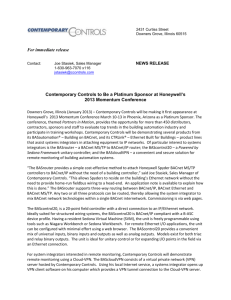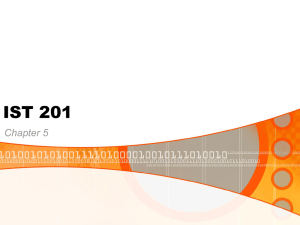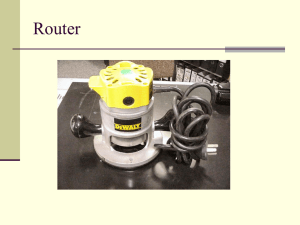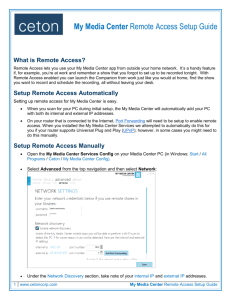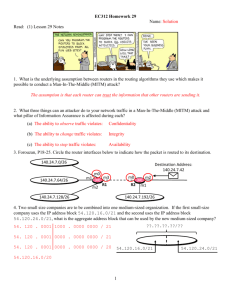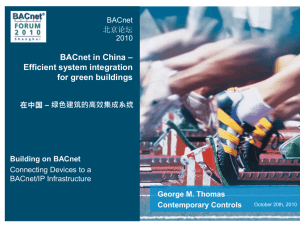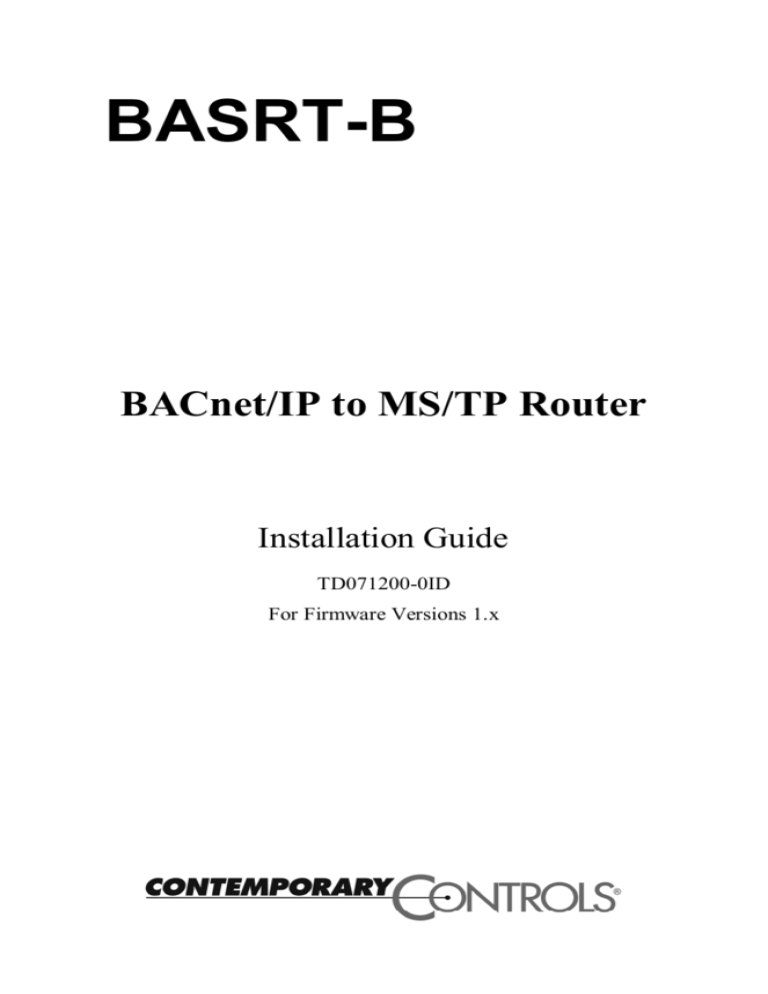
BASRT-B
BACnet/IP to MS/TP Router
Installation Guide
TD071200-0ID
For Firmware Versions 1.x
Trademarks
Contemporary Controls, ARC Control, ARC DETECT, EXTENDA-BUS, RapidRing, and CTRLink are trademarks or registered
trademarks of Contemporary Control Systems, Inc. Specifications
are subject to change without notice. Other product names may be
trademarks or registered trademarks of their respective companies.
BACnet is a registered trademark of the American Society of Heating,
Refrigeration, and Air-Conditioning Engineers, Inc. (ASHRAE).
TD071200-0ID 16 September 2009
Copyright
© Copyright 2009 by Contemporary Control Systems, Inc. All
rights reserved. No part of this publication may be reproduced,
transmitted, transcribed, stored in a retrieval system, or translated
into any language or computer language, in any form or by any
means, electronic, mechanical, magnetic, optical, chemical, manual,
or otherwise, without the prior written permission of:
Contemporary Control Systems, Inc.
2431 Curtiss Street
Downers Grove, Illinois 60515 USA
Tel:
1-630-963-7070
Fax:
1-630-963-0109
E-mail: info@ccontrols.com
Web:
www.ccontrols.com
Contemporary Controls Ltd
Sovereign Court Two, UWSP
Sir William Lyons Road
Coventry, CV4 7EZ, UK
Tel:
+44 (0)24 7641 3786
Fax:
+44 (0)24 7641 3923
E-mail info@ccontrols.co.uk
Web:
www.ccontrols.co.uk
Contemporary Controls (Suzhou) Co. Ltd
11 Huoju Road, Science & Technology Park
New District, Suzhou, PR China 215009
Tel:
+86-512-68095866
Fax:
+86-512-68093760
E-mail: info@ccontrols.com.cn
Web:
www.ccontrols.com.cn
Contemporary Controls GmbH
Fuggerstraße 1 B
04158 Leipzig, Germany
Tel:
+49 0341 520359 0
Fax:
+49 0341 520359 16
E-mail info@ccontrols.de
Web:
www.ccontrols.de
Disclaimer
Contemporary Control Systems, Inc. reserves the right to make
changes in the specifications of the product described within this
manual at any time without notice and without obligation of
Contemporary Control Systems, Inc. to notify any person of such
revision or change.
TD071200-0ID
2
Contents
1
Introduction ................................................................. 4
2
Specifications ............................................................... 5
Electrical ...................................................................... 5
Environmental .............................................................. 5
Mounting ..................................................................... 5
Functional .................................................................... 5
Electromagnetic Compatibility ..................................... 5
Connectors ................................................................... 6
EIA-485 Bias and Termination Jumpers ....................... 6
Mechanical .................................................................. 6
3
Power........................................................................... 7
POWER SUPPLY PRECAUTIONS ............................ 7
Limited Power Sources .............................................. 10
4
LEDS ......................................................................... 10
5
Operation ................................................................... 11
MS/TP Port ................................................................ 11
Ethernet Port .............................................................. 12
IP Address Reset Switch ............................................ 12
6
Webpage Configuration ............................................. 13
Device Parameter ....................................................... 16
BACnet/IP Parameters ............................................... 16
MS/TP Parameters ..................................................... 17
7
Warranty .................................................................... 19
8
Declaration of Conformity.......................................... 20
TD071200-0ID
3
1
Introduction
The BASRT-B routes messages between BACnet/IP and
BACnet MS/TP networks as per the ANSI/ASHRAE 135-2004
standard. It allows BACnet/IP devices operating over Ethernet to
communicate with MS/TP devices. The router is configurable
via its internal webpage.
The BASRT-B comes in a metal case, is DIN-rail mounted and
is powered from a 24 VAC/VDC source. It has one isolated
MS/TP port and one 10/100 Mbps Ethernet Auto-MDIX port.
The MS/TP port offers a 3-pin terminal block with a removable
plug for the EIA-485 connection. Through this port, up to 254
devices can be addressed — as many as 31 full-load devices on
the attached segment. All MS/TP baud rates (as stated in the
BACnet standard) are supported.
The Ethernet port offers a shielded RJ-45 connector. Through
auto-negotiation and Auto-MDIX, it automatically matches its
duplex setting, data rate and communication pair usage to
whatever is needed by the attached equipment. Thus, only a
straight-through CAT5 cable is needed for hook-up.
The BASRT-B features a user-accessible switch to reset the IP
address, subnet mask and gateway address to the factory defaults.
Three LEDs are present: A power LED glows green when proper
power is provided. The Ethernet LED glows green for 100 Mbps
operation and yellow for 10 Mbps and flashes to indicate activity.
A green LED flashes when MS/TP traffic is received.
Each unit complies with Class A radiated and conducted emissions
as defined by EN55022 and CFR 47, Part 15, and is intended for
use in non-residential areas.
When using the BASRT-B to communicate on routed IP networks
(ones which use multiple IP subnets), a separate device with BBMD
functionality must be provided. If all IP devices use the same
subnet, then BBMD functionality is not required. For example, if
the BASRT-B uses IP address 192.168.1.1 and another BACnet/IP
device (which will communicate with the BASRT-B) uses 10.0.0.1,
then BBMD functionality is required from another device on your
network.
TD071200-0ID
4
2
Specifications
Electrical
INPUT
Voltage (±10%):
Current (maximum):
Power:
Frequency:
DC
AC
24 V
125 mA
3W
N/A
24 V
125 mA
3 VA
47–63 Hz
(Class 2 Circuits Only)
Environmental
Operating temperature:
Storage temperature:
Relative humidity:
Mounting
Functional
0°C to 60°C
–40°C to +85°C
10–95%, non-condensing
TS-35 DIN-rail
Ethernet
MS/TP
Physical Layer:
10BASE-T
100BASE-TX
EIA-485
Cable length limit:
100 m
1200 m (for AWG 18)
MS/TP Baud rate (bps):
MS/TP node limit:
9600, 19200, 38400, 76800
MS/TP LED:
Ethernet LED:
flashing green = receive valid activity
254 devices total,
31 full-load devices per segment
green = 100 Mbps
yellow = 10 Mbps
flashing = activity
Regulatory Compliance
CE Mark; RoHS; CFR47, Part 15 Class A
Electromagnetic Compatibility
Each unit complies with Class A radiated and conducted emissions
as defined by EN55022 and CFR 47, Part 15. This equipment is
intended for use in non-residential areas.
Warning This is a Class A product as defined in EN55022. In a
domestic environment this product may cause radio interference in
which case the user may be required to take adequate measures.
TD071200-0ID
5
Connectors
3-pin (MS/TP) Pin Assignments
(Also explained on product label)
Figure 1 — 3-pin Connector
RJ-45 (MDI Ethernet) Pin Assignments
1
2
TD +
TD –
3
6
RD +
RD –
Figure 2 — RJ-45 Connector
(All other pins are unused.)
USB Mini B Connector (Aux)
This connector is only used for
firmware upgrades.
Figure 3 — USB Connector
EIA-485 Bias and Termination Jumpers
U Install jumper to apply pull-up bias.
T Install jumper to terminate bus.
D Install jumper to apply pull-down bias.
(All jumpers are installed by default.)
Figure 4 — Internal Jumpers
Mechanical
Figure 5 — Product Dimensions
TD071200-0ID
6
3
Power
The BASRT-B requires 24 VAC or 24 VDC (see Figure 6)
while drawing no more than 3 W of power. The recommended
conductor size is 16–18 AWG. COM is directly connected to
zero volts and the chassis is DC isolated from zero volts. Input
connections are reverse-polarity protected.
Figure 6 — Power Options
WARNING: Powering devices can present hazards. Read the
text on the following page carefully.
POWER SUPPLY PRECAUTIONS
Internally, the router utilizes a half-wave rectifier and therefore
can share the same AC power source with other half-wave
rectified devices. Sharing a common DC power source is also
possible. Sharing AC power with full-wave rectified devices is
NOT recommended. Full-wave rectified devices usually require
a dedicated AC power source that has a secondary elevated
above ground. Both secondary connections are considered HOT.
TD071200-0ID
7
AC power sources that power several half-wave devices have a
common secondary connection called either COMMON, LO, or
GROUND. This connection might be tied to frame ground or
earth. The other side of the secondary is considered the HOT or HI
side of the connection. Connect the HOT side of the secondary
to either the HI or the HIB input on the router and the LO side to
COM on the router. All other half-wave devices sharing the same
AC power source need to follow the same convention. When
using a DC power source, connect the positive terminal of the
source to either the HI or the HIB input and the negative terminal
to COM on the router. Reversing polarity to the router will not
damage the router. If shielded cable is used, it is recommended
to tie all shield segments together and connect one of the shield
ends to chassis while taping back the other.
For MS/TP devices that share a power source with the BASRT-B,
see Figure 7 for proper 2-wire bus connections and Figure 8 for
proper 3-wire bus connections.
WARNING: Devices powered from a common AC source
could be damaged if a mix of half-wave and full-wave rectified
devices exist. If you are not sure of the type of rectifier used by
another device, do not share the AC source with it.
Figure 7 — 2-wire MS/TP Bus with Shared Power Source
TD071200-0ID
8
Figure 8 — 3-wire MS/TP Bus with Shared Power Source
For MS/TP devices that use a power source separate from the
BASRT-B, see Figure 9 for proper 2-wire bus connections and
Figure 10 for proper 3-wire bus connections.
Figure 9 — 2-wire MS/TP Bus with Separate Power Sources
TD071200-0ID
9
Figure 10 — 3-wire MS/TP Bus with Separate Power Sources
Limited Power Sources
The router should be powered by a limited power source
complying with the requirements of the National Electric Code
(NEC) article 725 or other international codes meeting the same
intent of limiting the amount of power of the source. Under
NEC article 725, a Class 2 circuit is that portion of the wiring
system between the load side of a Class 2 power source and the
connected equipment. For AC or DC voltages up to 30 volts, the
power rating of a Class 2 power source is limited to 100 VA. The
transformer or power supply complying with the Class 2 rating
must carry a corresponding listing from a regulatory agency such
as Underwriters Laboratories (UL).
4
LEDs
Power glows green if power supplied to the unit is proper
Ethernet glows solid for a valid link (green for 100 Mbps or
yellow for 10 Mbps) and flashes to show activity
MS/TP flashes green when receiving valid MS/TP traffic
TD071200-0ID
10
5
Operation
MS/TP Port
The MS/TP port uses an isolated EIA-485 transceiver that is
connected to a 3-pin removable connector (Figure 1). The EIA485 transceiver’s + and – lines tie to + and – pins of the
connector. The SC pin ties to the circuit ground of the EIA-485
transceiver.
In Figure 11 a simplified schematic of the isolated EIA-485
transceiver is shown. Notice that the transceiver common (SC)
is electrically isolated from the router power supply common
(COM) through the use of opto-isolators and an isolated DC-DC
converter. By providing an isolated EIA-485 transceiver there is
less opportunity to damage the transceiver by subjecting it to
high common-mode voltages, but there is still a risk. Surge
suppression is applied between the two differential inputs and
between each input and ground. Since the transceiver is electrically
isolated, the transceiver’s circuit common must be brought out
for connection to the other devices on the MS/TP network. This
is accomplished by pin SC. The differential pair is labelled + and –
and corresponds to the same designations in the BACnet MS/TP
standard. This requires a three-wire connection to the MS/TP
network. When connecting other isolated MS/TP devices there
is no problem since each device requires a 3-wire connection.
Just make corresponding connections. For non-isolated MS/TP
devices, usually only a 2-wire connection is provided. The third
wire is the power supply common. In this situation, the SC
connection must be made to the power supply common of the
non-isolated device. Refer to the device vendor’s instructions
for connecting such a device.
In a router application where one connection is made to Ethernet
and the other to MS/TP, the location of the router is probably at
the end of the MS/TP bus segment and therefore both bias and
termination must be applied to the segment end. The router is
shipped with bias and termination applied, but this can be changed
by removing three jumpers. This should be done if the router is
to be connected anywhere between the end MS/TP devices.
TD071200-0ID
11
Figure 11 — Isolated EIA-485 Transceiver Circuitry
The router can address 254 MS/TP devices and supports 31 devices
on the local bus at rates of 9600, 19200, 38400, or 76800 bps.
EIA-485 Bias and Termination Jumpers
After removing the BASRT-B cover, three jumpers are accessible
on a 6-pin jumper block located near the MS/TP connector. These
impart 604 ohms of pull-up and pull-down bias at jumpers U and
D, and 130 ohms of termination impedance for the T jumper. With
all three jumpers installed, the effective termination resistance is
120 Ω — consistent with the BACnet standard. If the BASRT-B
is not installed at the end of a segment, remove all the jumpers
and install 120 Ω at the far end of the bus.
Ethernet Port
This port offers a shielded RJ-45 connector. Through auto-negotiation
and Auto-MDIX, it automatically matches its duplex setting, data
rate and communication pair usage to whatever is needed by the
attached equipment. Thus, any CAT5 cable (cross-over or straightthrough) may be used to connect to the Ethernet.
IP Address Reset Switch
To reset the router to it’s default values of the IP address
(192.168.92.68), gateway address (192.168.92.1) and netmask (/24
or 255.255.255.0), use a paperclip or similar tool to press the reset
button for at least 3 seconds while the router is powered. Release
the reset button. Then remove power from the router for 3 seconds.
Restore power and the unit will now use the default values.
TD071200-0ID
12
6
Webpage Configuration
Each router contains an interactive web server, accessible from
any Internet-compatible PC on the local network and compatible
with recent versions of Internet Explorer (5.0 or later, suggested)
or Netscape Navigator (7.1 or later, required). It is factoryprogrammed with a default IP address of 192.168.92.68 and a
Class C subnet mask of 255.255.255.0 (/24).
Figure 12 shows the setup for accessing the MS/TP network using
BASRT-B, a computer for configuration, and a connection to the
MS/TP network.
To configure the router, attach it to a computer with an Ethernet
connection and a standard web browser. For initial configuration,
the PC chosen for the procedure should temporarily have its IP
address modified as illustrated in Figure 13 — which employs a
Windows® XP example.
The example in Figure 13 suggests an IP address for the PC of
192.168.92.69, but the final quad of the address could be any
value from 3 to 254 — except for 68 which is used by the router.
After the IP address of the PC has been set to the same subnet as
the router, a browser can access the router via its default IP address.
Figure 12 — Setup for Initial IP Address Configuration
TD071200-0ID
13
On some systems, this
option is:
―My Network Places‖.
Figure 13 — Steps for Changing the IP Address of the PC Used for Setup
TD071200-0ID
14
After entering the router’s IP address into your browser’s address
field, you will see the Router Configuration Page with the default
values as shown in Figure 14 — using Windows Internet Explorer.
Figure 14 — Router Configuration Page with Default Values
Each configuration parameter is explained on the following pages.
When save changes is selected, the parameters are stored to nonvolatile memory and you are prompted to recycle power to the
unit. Until power is removed and then restored, your changes
will not apply.
TD071200-0ID
15
Device Parameter
Device Instance (Default Value = 0)
The router’s device instance is a 22-bit value (0–4,194,302). Do
not use 4,194,303 which is reserved by BACnet. Each BACnet
device within the same BACnet internetwork must have a unique
device instance. One must be assigned to the BASRT-B.
BACnet/IP Parameters
BACnet/IP UDP Port (Default Value = 0xBAC0)
This 16-bit hex value (BAC0–BACF) is set to BAC0 by default.
Usually, this default value should not be changed. In a typical
installation, each BASRT-B will be assigned the same UDP port.
BACnet/IP Network (Default Value = 1)
The BACnet/IP network number is a 16-bit value (1–65534).
Each network within the BACnet internetwork must have a
unique number. This includes the BACnet/IP and MS/TP sides
of the BASRT-B. Do not use addresses 0 or 65535 since these
addresses are reserved.
IP Address (Default Value = 192.168.92.68)
The IP address of the router can be 0.0.0.1–255.255.255.254. A
private address is usually assigned to the BASRT-B.
IP Subnet (Default Value = 24)
This value (0–30 in the ―slash‖ notation) is the number of bits
with a ―1‖ in the mask. The default value of 24 corresponds to
255.255.255.0 in the dotted decimal format. All devices on the
same subnet which communicate via BACnet/IP should use the
same subnet mask.
IP Gateway (Default Value = 192.168.92.1)
The default gateway for the IP stack is a dotted decimal number
in the range of 0.0.0.0–255.255.255.254. This will be the IP
address of your local IP router — if one exists.
TD071200-0ID
16
MS/TP Parameters
MS/TP MAC (Default Value = 00)
This is the unique 8-bit (0–127) MAC address of the router’s
MS/TP port, in decimal. Lower MAC address numbers are preferred
with the default recommended. It is further recommended that all
other BACnet devices attached to the same MS/TP network be
assigned consecutive MAC addresses beginning with 1 without
allowing any gaps in addressing. Slave devices may have MAC
addresses of 128–254, but MAC address 255 is reserved.
MS/TP Network (Default Value = 2001)
This 16-bit decimal network number (1–65534) must be unique
for all BACnet networks within the BACnet internetwork. No
other networks, regardless of type, can have the same network
number. Do not use addresses 0 or 65535 since these addresses
are reserved.
Max Masters (Default Value = 127)
Only master nodes participate in the MS/TP token-passing
process. The highest master MAC address (in decimal) in the
MS/TP network is 127 and you should use 127 if you are unsure
of other MS/TP device addresses. Each MS/TP device should
use this same value. For a value in this field to be proper, it must
equal or exceed the highest MAC address for any master on the
network. Optimum performance occurs when this value:
1. equals the highest MAC address of any master, and
2. all masters use sequential MAC addresses starting with 1
Since many BACnet devices do not allow this parameter to be
changed, leave the BASRT-B at the default value.
Max Info Frames (Default Value = 100)
This is the maximum number of messages that can be routed
onto the MS/TP network by the router per token pass. Its range
is 1–100, and typical values are 20–40. Smaller values provide
less access to the MS/TP network from the BACnet/IP network
because they give native MS/TP messages higher priority than
TD071200-0ID
17
those passed by the router from BACnet/IP. The default value
usually provides good performance.
MS/TP Baud Rate (Default Value = 38400)
The baud rate of the MS/TP network can be 9600, 19200, 38400
or 76800 bps. All MS/TP devices on the same MS/TP network
must use the same baud rate. On power up the router checks for
other masters; if finding none, it begins token passing — at which
point autobauding devices will adjust to the router’s baud rate.
MS/TP Tolerance (Default Selection = Strict)
This setting determines the degree to which interoperability with
devices is successful. The Lenient option is less efficient for
traffic flow but optimizes interoperability. A slight improvement
in performance will be realised by selecting the Strict setting.
TD071200-0ID
18
7
Warranty
Contemporary Controls (CC) warrants this product to the original
purchaser for two years from the product shipping date. Product
returned to CC for repair is warranted for one year from the date the
repaired product is shipped back to the purchaser or for the remainder of
the original warranty period, whichever is longer.
If the product fails to operate in compliance with its specification during
the warranty period, CC will, at its option, repair or replace the product
at no charge. The customer is, however, responsible for shipping the
product; CC assumes no responsibility for the product until it is received.
CC’s limited warranty covers products only as delivered and does not
cover repair of products that have been damaged by abuse, accident,
disaster, misuse, or incorrect installation. User modification may void the
warranty if the product is damaged by the modification, in which case this
warranty does not cover repair or replacement.
This warranty in no way warrants suitability of the product for any
specific application. IN NO EVENT WILL CC BE LIABLE FOR
ANY DAMAGES INCLUDING LOST PROFITS, LOST SAVINGS,
OR OTHER INCIDENTAL OR CONSEQUENTIAL DAMAGES
ARISING OUT OF THE USE OR INABILITY TO USE THE
PRODUCT EVEN IF CC HAS BEEN ADVISED OF THE
POSSIBILITY OF SUCH DAMAGES, OR FOR ANY CLAIM BY
ANY PARTY OTHER THAN THE PURCHASER.
THE ABOVE WARRANTY IS IN LIEU OF ANY AND ALL OTHER
WARRANTIES, EXPRESSED OR IMPLIED OR STATUTORY,
INCLUDING THE WARRANTIES OF MERCHANTABILITY,
FITNESS FOR PARTICULAR PURPOSE OR USE, TITLE AND
NONINFRINGEMENT.
Returning Products for Repair
Before returning a product for repair, contact Customer Service.
A representative will instruct you about our return procedure.
Contemporary Control Systems, Inc.
2431 Curtiss Street
Downers Grove, Illinois 60515 USA
Tel: +1-630-963-7070
Fax: +1-630-963-0109
E-mail: info@ccontrols.com
WWW: http://www.ccontrols.com
Contemporary Controls Ltd
Sovereign Court Two, UWSP
Sir William Lyons Road
Coventry CV4 7EZ UK
Tel: +44 (0)24 7641 3786
Fax: +44 (0)24 7641 3923
E-mail: info@ccontrols.co.uk
TD071200-0ID
19
8
Declaration of Conformity
Applied Council Directives:
Low Voltage Directive 2006/95/EC
General Product Safety Directive 2001/95/EC
Electromagnetic Compatibility Directive 2004/108/EC
Restriction of Hazardous Substances Directive 2002/95/EC
Waste Electrical and Electronic Equipment Directive 2002/96/EC
Standards to which Conformity is Declared
EN 55022:1998 + A1:2000 + A2:2003, Class A, Limits and
Methods of Measurement of Radio Disturbance Characteristics
of Information Technology Equipment
EN 55024:1998 + A1:2001 + A2:2003, Information Technology
Equipment — Immunity Characteristics — Limits and Methods
of Measurement
Manufacturer:
Authorized Representative:
Contemporary Control Systems, Inc.
2431 Curtiss Street
Downers Grove, IL 60515 USA
Contemporary Controls Ltd
Sovereign Court Two, UWSP
Sir William Lyons Road
Coventry CV4 7EZ UK
Type of Equipment:
BACnet/IP to MS/TP router
Model:
BASRT-B
I, the undersigned, hereby declare that the products specified
above conform to the listed directives and standards.
George M. Thomas, President
September 2009
TD071200-0ID
20


